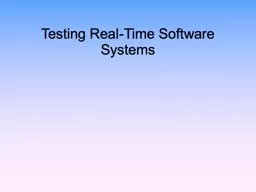

Overview What is a realtime system Must respond to external input within a finite and specified period of time Often are embedded systems designed for a dedicated platform and application Sometimes called ID: 782026
Download The PPT/PDF document "Testing Real-Time Software Systems" is the property of its rightful owner. Permission is granted to download and print the materials on this web site for personal, non-commercial use only, and to display it on your personal computer provided you do not modify the materials and that you retain all copyright notices contained in the materials. By downloading content from our website, you accept the terms of this agreement.
Slide1
Testing Real-Time Software Systems
Slide2Overview – What is a real-time system?
Must respond to external input within a finite and specified period of time
Often are embedded systems, designed for a dedicated platform and application
Sometimes called
reactive
systems because they react to changes in their environment (the other systems and processes they interact with)
Slide3Real-Time Software Systems
Slide4Types of real-time tasks
Periodic tasks – activated at a fixed frequency
Aperiodic tasks – can be activated at any point in time
Must have a constraint on activation pattern to achieve real-time timeliness
Example constraint: a minimum inter-arrival time, denoting the minimum time between two activations of the task
Slide5What are we looking for when testing?
Timeliness –
the ability of the software to meet time constraints
Worst-case execution time
Response time
– the time between activation of a task and its completion
Slide6Issues in testing real-time systems
Observability
For real-time software, this is the ability to log or monitor the
behavior
of
the system
Usually accomplished by using probes to reveal information about current state and state changes
Slide7Issues in testing real-time systems
Reproducibility
Difficult to achieve in real-time systems, because real-time systems are largely nondeterministic
Example: Response time depends on current system load, hardware components, etc.
May need to use statistical methods to ensure valid test results – usually by executing the program using the same input many times to get statistically significant data
Slide8Timeliness faults, errors, and failures
Timeliness fault –
a mistake in the implementation or configuration of a real-time system that results in incorrect temporal behavior
Example: An error in a loop condition that causes it to iterate more times than expected
Can also occur if some part of the environment behaves unexpectedly
Slide9Timeliness faults, errors, and failures
Timeliness error
– the system internally deviates from assumptions about its temporal behavior
Similar to internal state errors
Often hard to detect without extensive logging
Timeliness fault
– violation of a time constraint that can be observed externally
Usually easily detected, since constraints usually relate to the external behavior of the system
Slide10Testing Timeliness
Often difficult to use standard test criteria, since they rarely consider real-time information in test case generation
Traditionally timeliness is analyzed via scheduling analysis or regulated via admission control schemes
For these to work, assumptions about tasks and activation patterns must always be maintained
Analysis is often complex
Challenge is to find the inputs that will cause faults
Slide11Testing Timeliness
Typically, testing uses formal models of the softwareConstraint graphs – used to specify time constraints on system inputsTemporal logic – test case elements are pairs of timed inputs and outputs, which can then be combined and shifted in time to create many test cases. However, the number of pairs needed expands quickly as the program complexity increases (size, number of constraints, etc.)
Slide12Testing Timeliness
Timed automata – verifies sequences of timed action transactions via reliability analysis to determine which transactions should be tested. Again suffers from rapid expansion of states for large programs, which can be reduced somewhat using various sampling techniques.These and other modeling approaches are generally based on graph criteria
Slide13Testing Timeliness
Another approach based on mutation testing
Potential faults modeled as mutation operators, goal is to find those that have the potential to violate timeliness so test cases can be constructed for those mutants
Examples:
Task set mutation operator: changes the point in time when a resource is taken
Precedence constraint mutation operator: adds/removes precedence relations between pairs of tasks
Slide14An Example of A Real-Time Reactive System
Slide15A Bench-mark Example
Slide16Railroad Crossing
Several trains may cross one or more gates independently and simultaneously using non-overlapping tracksA train chooses the gate it intends to cross, and sends a request for entering the gate.The controlling system monitoring that gate receives the message and closes the gate. The system monitors the gate until no more train remains, then opens the gate
Slide17Scenario for “One Train, One gate and One Controller”
Slide18Timing Constraints
Slide19Timing Constraints –cont.
Slide20Class Diagram
Slide21Details
Slide22Finite State Machine for Train
Slide23Finite State Machine for Controller
Slide24Finite State Machine for Gate
Slide25Safety and liveness properties
Safety: bad things should not happene.g., two processes should not modify a variable at the same time. Liveness: good things should eventually happene.g., if I push the button, eventually the elevator should arriveCan be specified in temporal logic; more expensive to checkFairness (I should get lucky now and then) is an important and common class of liveness properties